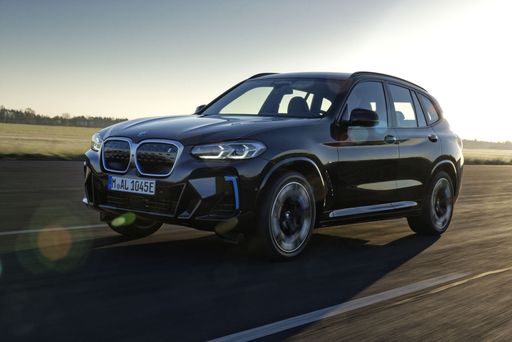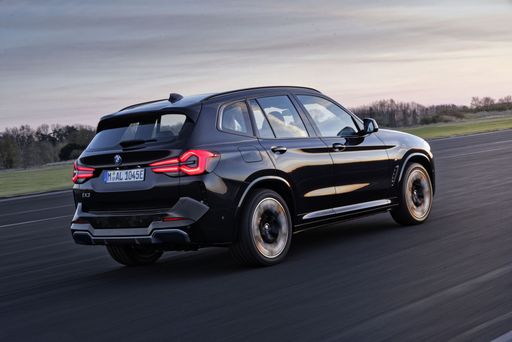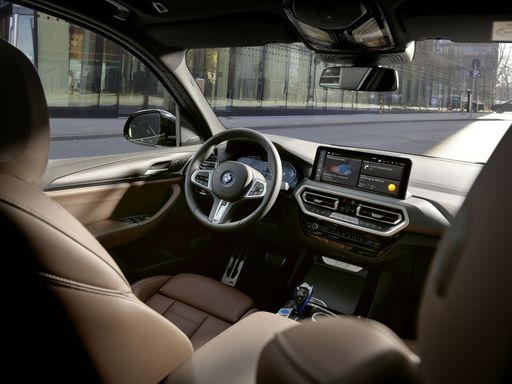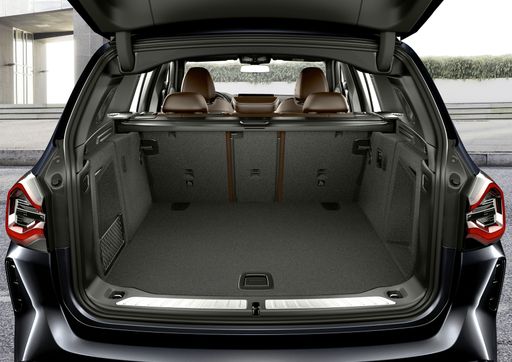BMW iX3 VS Nissan Interstar
BMW iX3
The BMW iX3 is an all-electric SUV that combines elegant design with sustainable technology, showcasing the brand's commitment to a greener future. Its refined interior offers a high level of comfort and advanced connectivity features, making it an attractive option for tech-savvy drivers. With its dynamic performance, the iX3 provides an engaging driving experience, proving that environmentally conscious solutions don't have to compromise on driving pleasure.
more informationNissan Interstar
The Nissan Interstar is a versatile van that expertly combines practicality with modern design. It offers a spacious interior that caters to both cargo and passenger needs, making it ideal for businesses and families alike. With its robust performance and efficient fuel consumption, the Interstar stands out as a reliable choice in the commercial vehicle market.
more information @ press.bmwgroup.com
@ press.bmwgroup.com
 @ press.bmwgroup.com
@ press.bmwgroup.com
 @ press.bmwgroup.com
@ press.bmwgroup.com
 @ press.bmwgroup.com
@ press.bmwgroup.com
Costs and Consumption |
|
|---|---|
|
Price
about 62200 - 70000
$
|
Price
about 35900 - 53800
$
|
|
Consumption L/100km
-
|
Consumption L/100km
7.4 - 7.5
L
|
|
Consumption kWh/100km
17.6
kWh
|
Consumption kWh/100km
-
|
|
Electric Range
471
km
|
Electric Range
-
|
|
Battery Capacity
73.9
kWh
|
Battery Capacity
-
|
|
co2
0
g/km
|
co2
194 - 195
g/km
|
|
Fuel tank capacity
-
|
Fuel tank capacity
80 - 105
L
|
Dimensions and Body |
|
|
Body Type
SUV
|
Body Type
Cargo Van
|
|
Seats
5
|
Seats
3
|
|
Doors
5
|
Doors
4
|
|
Curb weight
2270
kg
|
Curb weight
1927 - 2538
kg
|
|
Trunk capacity
510
L
|
Trunk capacity
-
|
|
Length
4734
mm
|
Length
5048 - 6848
mm
|
|
Width
1891
mm
|
Width
2070 - 2222
mm
|
|
Height
1668
mm
|
Height
2307 - 2808
mm
|
|
Payload
470
kg
|
Payload
845 - 1451
kg
|
Engine and Performance |
|
|
Engine Type
Electric
|
Engine Type
Diesel
|
|
Transmission
Automatic
|
Transmission
Manuel, Automatic
|
|
Transmission Detail
Reduction Gearbox
|
Transmission Detail
Manual Gearbox, Automatic Gearbox, Automated Manual
|
|
Drive Type
Rear-Wheel Drive
|
Drive Type
Front-Wheel Drive, Rear-Wheel Drive
|
|
Power HP
286
HP
|
Power HP
105 - 180
HP
|
|
Acceleration 0-100km/h
6.8
s
|
Acceleration 0-100km/h
-
|
|
Max Speed
180
km/h
|
Max Speed
140 - 177
km/h
|
|
Torque
400
Nm
|
Torque
330 - 400
Nm
|
|
Number of Cylinders
-
|
Number of Cylinders
4
|
|
Power kW
210
kW
|
Power kW
77 - 132
kW
|
|
Engine capacity
-
|
Engine capacity
1997 - 2299
cm3
|
|
Top speed
180
km/h
|
Top speed
140 - 177
km/h
|
General |
|
|
Model Year
2021
|
Model Year
2021 - 2024
|
|
CO2 Efficiency Class
A
|
CO2 Efficiency Class
G
|
|
Brand
BMW
|
Brand
Nissan
|
BMW iX3
Introducing the BMW iX3: A Pioneering Electric SUV
The BMW iX3 combines the renowned German engineering and luxury with innovative electric technology. Designed to cater to SUV enthusiasts looking for a sustainable yet powerful driving experience, the iX3 stands out in the rapidly evolving electric vehicle market.
Powerful Performance: Under the Bonnet of the iX3
At the heart of the BMW iX3 is an electric motor delivering an impressive 286 PS. This equates to a robust 210 kW, ensuring a dynamic drive that doesn't compromise on excitement. With a top speed of 180 km/h, the iX3 proves that efficiency doesn't mean sacrificing performance. The electric SUV accelerates from 0 to 100 km/h in just 6.8 seconds, showcasing its agility and power.
Innovative Electric Technology and Efficiency
The BMW iX3 boasts a remarkable electric range of up to 471 km, thanks to its 73.9 kWh battery pack. With an energy consumption of 17.6 kWh/100 km, the SUV is designed to optimise energy usage without compromising on the driving experience. Furthermore, the iX3 features CO2 emissions of 0 g/km, earning it a top-notch CO2 efficiency rating of class A. This model exemplifies BMW’s commitment to a more sustainable future.
Design and Comfort: Luxury Meets Sustainability
As an SUV, the BMW iX3 offers a spacious interior with seating for five and a generous boot capacity of 510 litres. The vehicle's dimensions, including a length of 4734 mm and width of 1891 mm, ensure ample room for both passengers and luggage. The iX3 is available in two equipment lines, 'Impressive' and 'Inspiring', ensuring a customised experience that matches individual preferences and lifestyles.
Safety and Driving Assistance
The iX3 comes equipped with a suite of advanced safety features and driving assistance systems, highlighting BMW’s commitment to safety. The integration of cutting-edge technologies ensures a reassuring and enjoyable driving experience in various conditions.
Pricing and Value
With pricing ranging from €67,300 to €75,700, the BMW iX3 positions itself as a competitive option in the premium electric SUV market. The monthly costs are estimated to be between €1,449 and €1,580, catering to those who desire a balance between luxury and sustainability in their vehicular choice.
Conclusion: The Future of Driving with BMW iX3
The BMW iX3 is a testament to the brand's forward-thinking approach in the realm of electric vehicles. By combining luxury, performance, and sustainability, the iX3 sets a new standard for what an electric SUV can be. Its outstanding range, sophisticated design, and advanced technology make it a compelling choice for the environmentally conscious driver who refuses to compromise on quality.
Nissan Interstar
The Evolution of the Nissan Interstar
The Nissan Interstar has long been a staple in the commercial vehicle sector, known for its robust build and practical design. The latest iterations have further cemented its status with a range of technical enhancements and innovative features aimed at aiding businesses in achieving optimal efficiency. Whether you're navigating city streets or traversing the highways, the Interstar stands out as a reliable workhorse ready to meet various transport needs.
Power and Performance
The current range of Nissan Interstar models boasts diesel engines ranging from 105 to 180 PS, offering a commendable blend of power and fuel efficiency across the board. With a fuel consumption of between 7.4 and 7.5 litres per 100 kilometres, these vehicles are designed to minimise operational costs while maximizing performance.
All models feature four-cylinder engines, with engine displacement between 1997 and 2299 cm³, capable of producing torque figures between 330 and 400 Nm. These specifications ensure that the Interstar offers superior pulling power, which is particularly useful for transporting heavy loads across different terrains.
Transmission and Drive Options
Versatility is at the heart of the Nissan Interstar, with transmission options including both manual and automatic gearboxes. Drivers can also choose between front-wheel and rear-wheel drive configurations, allowing the vehicle to suit specific logistical requirements or personal preferences.
For those seeking simplicity and ease of use in urban environments, the Interstar with its automated gearshift provides a smooth driving experience, reducing driver fatigue and increasing focus on the road ahead.
Dimensions and Load Capacities
The Nissan Interstar is available in various lengths, from 5048 mm to an extensive 6848 mm, catering to diverse commercial needs. With widths ranging from 2070 mm to 2222 mm and heights from 2307 mm to 2808 mm, the Interstar offers multiple configurations to maximise cargo space and accommodate various loads.
With a maximum payload capacity of up to 1451 kg, businesses can rest assured that the Interstar is more than capable of delivering goods efficiently without compromising on safety or comfort.
Innovation and Technological Features
While functionality remains a priority, Nissan has not skimped on technological advancements. Among the innovations included are advanced safety features, such as anti-lock braking systems (ABS), electronic stability control (ESC), and a variety of sensors to assist with parking and reversing.
In terms of driver comfort, the brand offers multiple trim levels with exceptional interior features designed to enhance driver experience during long hauls. Options such as climate control, advanced navigation systems, and modern infotainment setups are available, ensuring that both driver and passenger remain comfortable and connected, regardless of the journey length.
Coachwork and Trim Options
The Interstar line-up provides a range of trim levels and equipment lines, from the entry-level Visia to the high-spec Tekna, catering to different market demands and individual preferences. The selection allows buyers to prioritise features that best suit their operation or driving style.
For example, the N-CONNECTA variant offers an array of added extras, enhancing both connectivity and comfort for drivers who rely on the vehicle as a mobile office.
Conclusion
The Nissan Interstar represents a harmonious blend of power, efficiency, and technological innovation in the large van segment. With its vast array of options and features, the Interstar is undeniably a top choice for businesses looking to invest in a dependable and adaptable commercial vehicle. As the line-up continues to evolve, the Interstar remains poised to meet the growing challenges and demands of the modern logistic landscape.
